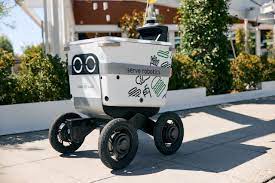Introduction
In the rapidly evolving world of food delivery, the integration of autonomous technology is making significant waves. Shake Shack, the renowned fast-casual restaurant chain, has partnered with Serve Robotics, a leader in autonomous delivery solutions, to launch a groundbreaking initiative in Los Angeles. This collaboration is set to redefine the convenience and efficiency of food delivery, leveraging sidewalk robots to bring Shake Shack’s beloved menuShake Shack directly to customers’ doors. This article delves into the details of this innovative deployment, its potential impact, and the broader implications for the food delivery industry.
Table of Contents
The Partnership: Shake Shack and Serve Robotics
Shake Shack, founded in 2001 in New York City, has grown into a global sensation known for its high-quality burgers, fries, and shakes. The company’s commitment to customer satisfaction and innovation is evident in its latest venture into autonomous delivery.

Serve Robotics, a subsidiary of Postmates, is at the forefront of autonomous delivery technology. Their sidewalk robots are designed to navigate urban environments, providing a contactless, eco-friendly alternative to traditional delivery methods. The partnership with Shake Shack aims to blend the convenience of robotic delivery with the high standards of one of the most popular fast-food chains.
The Technology Behind the Robots
Serve Robotics’ autonomous sidewalk robots are engineered to handle a variety of delivery challenges. These robots are equipped with advanced sensors, cameras, and GPS technology, allowing them to navigate sidewalks, avoid obstacles, and interact safely with pedestrians.
- Navigation and Safety: The robots use a combination of LiDAR, cameras, and machine learning algorithms to create a detailed map of their surroundings. This enables them to identify and navigate around obstacles such as pedestrians, pets, and other objects. The technology also includes real-time monitoring by a remote team to address any unforeseen issues.
- Delivery Process: Once a delivery is dispatched, the robot follows a predetermined route to the customer’s location. Customers can track their robot in real-time via a mobile app, providing transparency and allowing them to anticipate the arrival of their order.
- Interaction and Security: At the delivery location, the robot’s secure compartment opens only when the customer verifies their identity through the app. This ensures that orders are delivered safely and to the correct recipient.
Implementation in Los Angeles
Los Angeles, with its sprawling urban landscape and heavy reliance on food delivery services, is an ideal testing ground for autonomous sidewalk robots. The city’s diverse neighborhoods and high volume of deliveries present both opportunities and challenges for this technology.
- Service Areas: The initial rollout will focus on key neighborhoods known for high demand, including Downtown LA, Hollywood, and Santa Monica. This strategic approach allows Shake Shack and Serve Robotics to optimize their operations and gather valuable data to refine the service.
- Customer Experience: The introduction of autonomous robots aims to enhance the customer experience by reducing delivery times and providing a contactless option. With the robots’ ability to navigate through traffic and deliver orders directly to the customer’s door, the convenience factor is significantly increased.
- Regulatory and Operational Challenges: Operating autonomous robots in a densely populated city like Los Angeles involves navigating complex regulatory frameworks and urban infrastructure. Both Shake Shack and Serve Robotics have been working closely with city officials to ensure compliance with local regulations and to address any operational challenges that arise.
Benefits of Autonomous Delivery Robots
The deployment of autonomous sidewalk robots offers several advantages over traditional delivery methods:
- Efficiency and Speed: Robots can operate around the clock, potentially reducing delivery times and increasing overall efficiency. Their ability to follow precise routes and avoid congestion can streamline the delivery process.
- Cost Savings: By reducing the need for human delivery drivers, Shake Shack and Serve Robotics can lower operational costs. These savings can potentially be passed on to customers through more competitive pricing.
- Environmental Impact: Electric-powered robots contribute to a reduction in carbon emissions compared to traditional delivery vehicles. This aligns with Shake Shack’s commitment to sustainability and serves as a step toward more eco-friendly business practices.
- Enhanced Safety: The contactless nature of robotic deliveries minimizes physical interaction between delivery personnel and customers, which can be particularly beneficial in health-conscious times or for customers preferring minimal contact.
Challenges and Considerations
Despite the many benefits, the integration of autonomous delivery robots is not without challenges:
- Public Acceptance: Gaining public trust and acceptance for autonomous robots requires continuous education and positive user experiences. Shake Shack and Serve Robotics need to address any concerns related to safety, privacy, and reliability.
- Technical Limitations: While the technology is advanced, robots can still encounter limitations such as inclement weather, complex urban environments, or unexpected obstacles. Continuous refinement and adaptation are necessary to overcome these hurdles.
- Regulatory Hurdles: Navigating the regulatory landscape for autonomous vehicles involves compliance with various local, state, and federal guidelines. Ensuring that the robots meet all regulatory requirements is crucial for successful deployment.
Future Prospects
The successful implementation of autonomous sidewalk robots in Los Angeles could pave the way for similar initiatives in other cities. As technology advances and public acceptance grows, we can expect to see a broader adoption of autonomous delivery solutions across various sectors.
- Expansion Plans: If the Los Angeles pilot proves successful, Shake Shack and Serve Robotics may look to expand the service to other cities with similar urban dynamics and high delivery demands.
- Technology Enhancements: Future improvements could include enhanced AI capabilities, better integration with other delivery systems, and greater operational efficiency.
- Industry Impact: The adoption of autonomous delivery robots could set a precedent for other food and retail businesses, potentially transforming the logistics and delivery .







